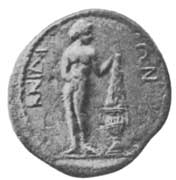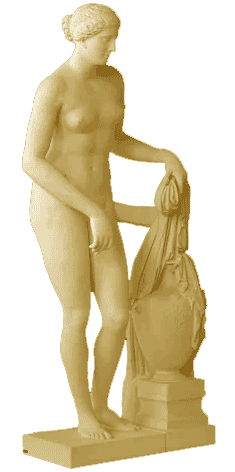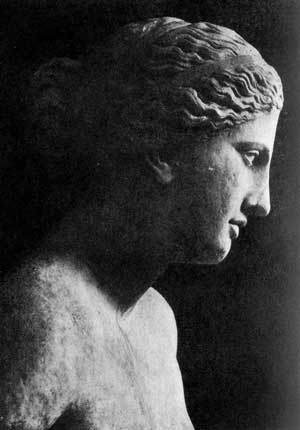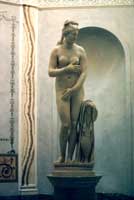.

Cnidus Coin with the Aphrodite of Cnidus
As Polybius writes, Aphrodite was angry when she saw her statue in public. "Where did Praxiteles see me naked?" she asked. This story tells us that the statue of Praxiteles was so realistic showing all the beauty, but maybe also the small imperfections, of the goddess of beauty and this is the reason of Aphrodite's reaction.


Aphrodite of Knidos (Cnidos or Cnidus) on the verge of stepping forward, with her drapery over a water pot, one of many copies and versions, A work of Praxiteles, probably the first completely nude Aphrodite sculpture. Praxiteles was famous for producing a smooth silky skin. The statue was probably transported to Byzantium where it was destroyed like many other pieces of Greek Art. Zonaras, early twelfth century, repeats Cedrenus, saying that "the fire also destroyed the beautiful palace of Lausus and the statues therein, the Hera of Samos, the Athena of Lindos, and the Aphrodite of Cnidos, famous masterpieces of art." Here a fire is described around 475 AD.

Paul Carus. Venus of Milo: An Archaeological Study of Woman. The Open Court Publishing Company, 1916. Page 160. A view of the right side of the Colonna Venus, an ancient replica of the Aphrodite of Knidos , Vatican Museums in Rome, Italy

Capitoline Venus, replica version of the Aphrodite of Cnidus by Praxiteles. Roman artwork of the Imperial Era, 2th century AD. Marble. Figured amongst the Borghese Collection. Location: Louvre (Ma 335) Photographer: Jastrow (2005)
An example of a "pudica" pose where a hand is used to cover her private parts. A so called Venus Pudica, from Pudens (being modest or ashamed) .

A curiosity of nature the Venus Medici Carrot, 1912

Venus, Capitoline Museum, Rome

Praxiteles, a student of Pheidias, born c. 400 BC, active approximately in the period (380-325) BC. Praxiteles produced bronze and marble sculptures but was more famous for the later according to Pliny the Elder. What we know is that probably Aphrodite of Knidos is actually the sculpture of Phryne, a famous Hetaera (from the city Thespiae) in Athens. She was the favorite model of Praxiteles and also a favorite of the orator and politician Hypereides who had to pay more than 100 times the price of a normal prostitute (1 drachma usually) to Phryne. Hetaerae are something like the Geishas in Japan, they are educated, play the aulos and other musical instruments and they are able to talk about philosophical problems. The Athenians considered it as a scandal that she was used as a model for Aphrodite but more likely they did not like her independent life style as a woman. In 340 they tried to punish her but Hypereides was able to save her using his rhetoric power. Phryne (390-330 BC) was a very rich woman. When Alexander the Great destroyed Theben she offered her help to rebuild the complete surrounding wall of the citty with her money.
When we had taken sufficient delight in the garden plants, we entered the temple. The goddess is placed in the middle -- she's a most beautiful statue of Parian marble -- smiling just a little haughty smile. Since she is swathed in no clothes all her naked beauty is revealed, except that she unobtrusively uses one hand to hide her modesty. So great was the power of the craftsman's art that the hard unyielding marble has done justice to every limb. . . . The temple has a door on both sides for those who wish to see the goddess directly from behind so that no part of her be left unadmired. It's easy, therefore, for people to enter by this other door and survey the beauty of her back. Deciding, then, to see all of the goddess we went round to the rear. And as the door was opened by the woman responsible for keeping the keys, immediate amazement at her beauty seized us. The Athenian who had been an impassive observer shortly before . . . suddenly shouted, "Herakles! What a well-shaped back, what generous flanks, what an armful to embrace! How delicately moulded the flesh of her behind, neither too thin and close to the bone, nor yet revealing too great an expanse of fat! And as for those precious parts sealed in on either side by the hips, how inexpressibly sweetly they smile! How perfect the shape of the thighs and shins as they stretch down to the ankle!"
Lucian, Amores
There are works by him [Praxiteles] at Athens in the Ceramicus, but first and foremost not only of this, but indeed in the whole world, is the Venus that many have sailed to Cnidus to see. He made two statues and put them up for sale together: one was draped and for that reason was preferred by the people of Cos, who had an option on the sale, even though it was the same price as the other, for they judged this to be the sober and proper thing to do. The Cnidians bought the rejected one, whose fame became immensely greater.
Later King Nicomedes wanted to buy it, promising that he would pay off the city's entire foreign debt, which was enormous. The Cnidians, however, preferred to suffer anything but this, and not without reason, for with this statue, Praxiteles had made Cnidus famous. The shrine she stands in is completely open, so that one can view the image of the goddess from all sides, an arrangement (so it is believed) that she herself favored. The statue is equally admirable from every angle. There is a story that a man was once overcome with love for it, hid inside during the night, and embraced it, leaving a stain to mark his lust.
Pliny
From The Deipnosophists of Athenaeus of Naucratis, Book XIII Concerning Women:
Now Phryne came from Thespiae. When she was brought to trial by Euthias on a capital charge she was acquitted; this so enraged Euthias that he never afterwards pleaded another case at law, according to Hermippus. As Hypereides, while defending Phryne, was making no progress in his plea, and it became apparent that the judges meant to condemn her, he caused her to be brought where all could see her; tearing off her undervests he laid bare her bosom and broke into such piteous lamentation in his peroration at the sight of her, that he caused the judges to feel superstitious fear of this handmaid and ministrant of Aphrodite, and indulging their feeling of compassion, they refrained from putting her to death. And after she had been acquitted a decree was passed that no person speaking in a defendant's behalf should indulge in lamentation, nor should the accused man or woman on trial be bared for all to see. As a matter of fact, Phryne was more beautiful in the unseen parts. Hence one could not easily catch a glimpse of her naked; for she always wore a tunic which wrapped her body closely, and she did not resort to the public baths. At the great assembly of the Eleusinia and at the festival of Poseidon, in full sight of the whole Greek world, she removed ony her cloak and let down her long hair before stepping into the water; she was the model for Apelles when he painted his Aphrodite Rising from the Sea. So, too, the sculptor Praxiteles, being in love with her, modelled his Cnidian Aphrodite from her, and on the pedestal of his Eros below the stage of the theatre he wrote an epigram: "Praxiteles hath portrayed to perfection the Passion (Eros) which he bore, drawing his model from the depths of his own heart and dedicating Me to Phryne as the price of Me. The spell of love which I cast comes no longer from my arrow, but from gazing upon Me." He also gave her a choice of his statues, to see whether she wished to take his Eros, or his Satyr, which stood in the Street of the Tripods. She chose the Eros and set it up as a votive offering in Thespiae. Of Phryne herself the neighbors made and set up a golden statue at Delphi, on a pillar of Pentelic marble; Praxiteles executed the work. When the Cynic Crates saw it he called it an offering dedicated to Greek incontinence. This image stands midway between that of Archidamus, king of Lacedaemon, and that of Philip, the son of Amyntas, and bears a label, "Phryne, daughter of Epicles, of Thespiae"; so says Alcetas in the second book of his work On the Dedicatory Offerings at Delphi. Now Apollodorus in his book On Courtesans records that there were two Phrynes, one of whom, he says, was nicknamed Teary-Smile, the other Goldfish. But Herodicus in the sixth book of his Persons Mentioned in Comedy says that in the orators the one was called Sestus because she sifted (sethein) and stripped all who resorted to her, whereas the other was the Thespian. Now Phryne was very rich, and used to promise that she would build a wall about Thebes if the Thebans would write an inscription upon it, that "Whereas Alexander demolished it, Phryne the courtesan restored it"; so records Callistratus in his book On Courtesans. Her wealth is spoken of by the comic poet Timocles in Neaera (his testimony has been cited above) and by Amphis in The Tire-Woman. Yet Gryllion, a member of the Areopagus, played the parasite at Phryne's board, as Satyrus, the actor from Olynthus, did at Pamphila's. Aristogeiton, in the speech Against Phryne, says that her real name was Mnesarete. I am not unaware that the speech against her which is ascribed to Euthias is said by Diodorus the Geographer to be by Anaximenes. Now the comic poet Poseidippus says of her these words, in The Woman from Ephesus: "Phryne was once the most illustrious of us courtesans by far. And even though you are too young to remember that time, you must at least have heard of her trial. Although she was thought to have wrought too great injury to men's lives, she nevertheless captured the court when tried for her life, and, clasping the hands of the judges, one by one, she with the help of her tears saved her life at last."
Hetaerae had more than other women a control over their money. They were often very rich, one known from early times was the Egyptian Hetaera Rhodopis, who was probably freed as a slave by Charaxus the brother of Sappho according to Herodotus. With her money she supported financially the building of a pyramid.
| Ancient Greece
Science, Technology , Medicine , Warfare, , Biographies , Life , Cities/Places/Maps , Arts , Literature , Philosophy ,Olympics, Mythology , History , Images Medieval Greece / Byzantine Empire Science, Technology, Arts, , Warfare , Literature, Biographies, Icons, History Modern Greece Cities, Islands, Regions, Fauna/Flora ,Biographies , History , Warfare, Science/Technology, Literature, Music , Arts , Film/Actors , Sport , Fashion --- |

